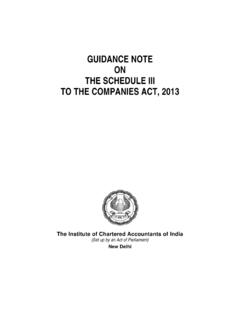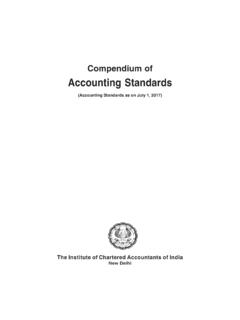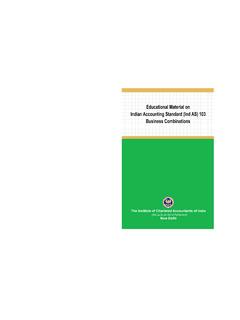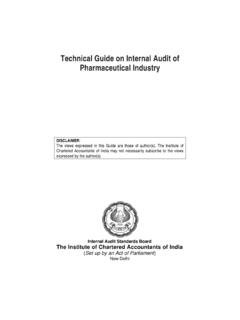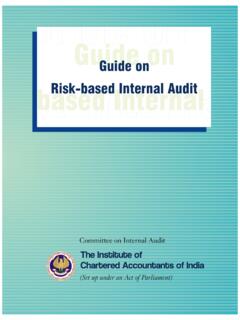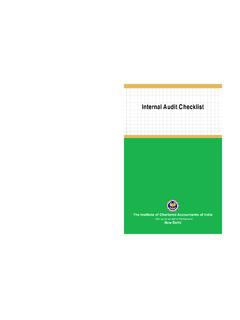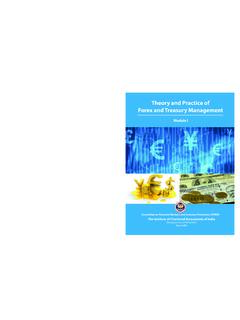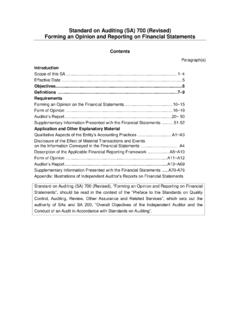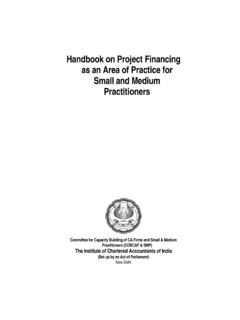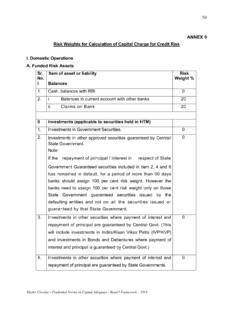Transcription of HANDBOOK ON MICROFINANCE INSTITUTIONS
1 1 HANDBOOK ON MICROFINANCE INSTITUTIONS 2 INDEX CHAPTERS PARTICULARS 1 BIRTH OF MICROFINANCE HISTORY WHAT IS MICROFINANCE ? HOW DOES MICROFINANCE HELP THE POOR? 2 GLOBAL IDEA OF MICROFINANCE 3 MICROFINANCE SECTOR IN INDIA MAJOR AND RELATIVELY RECENT DEVELOPMENTS IN THE MICROFINANCE SECTOR BANKING CORRESPONDENT MODEL AND BANKING FACILITATOR MICRO FINANCE INSTITUTIONS (DEVELOPMENT AND REGULATIONS) BILL 2011 4 LEGAL FRAMEWORK SOCIETIES REGISTRATION ACT, 1860 INDIAN TRUSTS ACT, 1882 NOT-FOR-PROFIT COMPANIES REGISTERED UNDER SECTION 25 OF COMPANIES ACT, 1956(Ref. Section 8 under Companies Act 2013) NON BANKING FINANCIAL INSTITUTIONS NIDHI COMPANIES(Ref. Section 406 under Companies Act 2013) 5 PRODUCTS OF MICROFINANCE OBJECTIVE MICROSAVINGS INSURANCE REMITTANCE NON-FINANCIAL PRODUCTS INVESTMENT CRITERION JOINT LIABILITY GROUP PRODUCT 6 FINANCIAL INCLUSION AND RBI MANDATE 3 7 FINANCIAL REPORTING OF MICROFINANCE TYPES OF SOURCES ACCOUNTING PRACTICES FOLLOWED FINANCIAL REPORTING USERS OF FINANCIAL REPORTS METHODS OF ACCOUNTING APPLICABILITY OF ACOUNTING STANDARDS PROFIT AND LOSS ACCOUNT ( income AND EXPENDITURE ACCOUNT) FORMAT FORMAT OF BALANCE SHEET 8 TAXATION OF MICROFINANCE SOCIETIES AND TRUSTS NBFCS AND OTHER LOCAL BANKS CO-OPERATIVE SOCIETIES INCLUDING MULTI STATE CO-OPERATIVE SOCIETIES CO-OPERATIVE BANKS SECTION 25 COMPANIES (Ref.)
2 Section 8 under Companies Act 2013) 9 FRAUDS IN MICROFINANCE WAYS OF UNDERTAKING FRAUDS EXAMPLES OF FRAUD COMMON CONDITIONS MAKING MICRO FINANCE INSTITUTIONS ATTRACTIVE TOWARDS FRAUDS SUMMARY FOR REASONS OF FRAUDS 10 CODE OF CONDUCT FOR MICROFINANCE INSTITUTIONS APPLICATION OF THE CODE INSTITUTIONAL CONDUCT GUIDELINES FOR MICROFINANCE INSTITUTIONS CLIENT PROTECTION GUIDELINES FOR MICROFINANCE INSTITUTIONS 4 11 BUSINESS CORRESPONDENCE MODEL OF MICROFINANCE WHAT IS BUSINESS CORRESPONDENCE MODEL? VIABLITY OF BC MODEL BC CAN BECOME AN EFFECTIVE TOOL FOR FINANCIAL INCLUSION THE BC MODEL HAS BENEFITS FOR BOTH THE BANKS AND THE MFIS THE BENEFITS OF THE BC MODEL FOR MFIS ARE MANIFOLD GUIDELINES BY THE RESERVE BANK OF INDIA ENTITIES ELIGIBLE TO BECOME BC FROM BANK 12 PROCEDURE FOR CASH CREDIT LIMITS FROM MICROFINANCIAL INSTITUTIONS AND TERM LOANS FROM OTHER NBFCs PROCEDURAL FOR CASH CREDIT LIMITS FROM MICROFINANCIAL INSTITUTIONS 12,2 BASIC FORMALITIES FOR SECURING CASH CREDIT FROM BANKS BASIC FORMALITIES INVOLVED IN SECURING A CASH CREDIT FROM BANKS TERM LOAN FROM OTHER NBFCS 13 CONSTRAINTS OF MICROFINANCE RISK RISE IN CREDIT AND FUNDING.
3 RISK OF MFIS IN ASIAN COMPANIES TYPE OF RISK OF MFIS IN PRACTICES 14 SMALL ENTERPRISE DEVELOPMENT AND MICROENTERPRENUERS MICROENTERPRISE MICROFINANCE HOW DO MFIS MEET THE NEEDS OF SMALL ENTERPRISES? UNDERSTANDING THE FINANCIAL NEEDS OF SMALL ENTERPRISES THREE REASONS WHY MFIS ARE INTERESTED IN SERVING SMALL BUSINESSES MFIS CHALLENGES IN SERVING SMALL BUSINESS 5 INADEQUATE MFI PRODUCTS LACK OF A SPECIALIZED DEPARTMENT AND STAFF WEAK PORTFOLIO MANAGEMENT AND DATA ANALYSIS 15 SUPPORTING WOMEN IN THE INFORMAL SECTOR WOMEN AS MICRO ENTREPRENEURS IN THE INFORMAL SECTOR PROVIDING WOMEN ENTREPRENEURS WITH SUSTAINABLE ACCESS TO MICROFINANCE 16 MICRO FINANCE INSTITUION DUE DILIGENCE-GUIDE ON REVIEW OF MICROCREDIT PORTFOLIO THE DUE DILIGENCE PROCESS TIER I DUE DILIGENCE TIER II DUE DILIGENCE TIER 3 DUE DILIGENCE 17 ANALYSIS OF MICROFINANCE BILL 2011 AND 2012 BRIEF ABOUT SECTIONS FEATURES OF MFI BILL-2012
4 VIS A VIS THE DRAFT BILL 2011 18 TOP 10 MICROFINACIAL INSTITUTIONS IN THE WORLD 19 FUTURE PROSPECTS OF MICROFINANCE 20 PROFFESIONAL OPOURUNITIES IN MICROFINANCE 21 ANNEXURE 1- Self Regulatory Organization (SRO) for NBFC-MFI 2- master circular Corporate Governance 3- Guidelines on Fair Practices Code for NBFCs 4- The Micro Finance INSTITUTIONS (Development and Regulation) Bill 2012 6 CHAPTER: 1 BIRTH OF MICROFINANCE HISTORY Money is required for every single step of Business Life-Cycle, Micro Finance is about the finance to satisfy the need for small entrepreneurs to fulfill or to set up a business at a small scale and give a source of livelihood to people from poor villages, and increase the standard to live life in an optimistic manner.
5 Franciscan monks founded the community-oriented pawnshops in the 15th century, The history of microfinancing can be traced back as far as the middle of the 1800s, when the theorist Lysander Spooner was writing about the benefits of small credits to entrepreneurs and farmers as a way of getting the people out of poverty The founders of the European credit union movement in the 19th century(Spooner, Friedrich Wilhelm Raiffeisen) founded the first cooperative lending banks to support farmers in rural Germany. The birth of modern micro-finance is said to have occurred in the mid 1970s in rural Bangladesh when the founders of the microcredit movement in the 1970s as Dr. Muhammad Yunus (professor of economics at the University of Chittagong) and Al Whittaker, have tested 7 practices and built INSTITUTIONS designed to bring the kinds of opportunities and risk-management tools that financial services can provide to the doorsteps of poor people.
6 While the success of the Grameen Bank, which serves over 7 million poor Bangladeshi women has inspired the world. In nations with lower population densities, meeting the operating costs of a retail branch by serving nearby customers has proven considerably more challenging. To find a practical solution, Dr. Muhammad Yunus began visiting local villages. In one nearby village, Jorba, he found a group of 42 women who made bamboo stools. Because they lacked the funds to purchase the raw materials themselves, they were tied into a cycle of debt with local traders, who would lend them the money for the materials on the agreement that they would sell the stools at a price barely higher than the raw materials. Yunus was shocked to find that the entire borrowing needs of the 42 women amounted to the equivalent of US$27.
7 He lent them the money from his own pocket at zero interest, enabling the women to sell their stools for a reasonable price and break out of the cycle of debt. Another pioneer in this sector is Akhtar Hameed Khan Inspired by the success of The Grameen Bank, the 1970s and 80s saw rapid growth in the number of new micro-finance INSTITUTIONS appearing around the world, many of them started by NGOs and funded by grants and subsidies from public and private sources. They demonstrated that the poor could be relied on to repay their loans, even without collateral, and hence that micro-finance was a potentially viable business. During the 1990s, the industry began to realize that it could not continue to grow at such rates while still relying on grant funding.
8 As a result, many began to restructure themselves to attract commercial investors, adopting more formal business practices and working to improve their efficiency and sustainability. 1998 saw the formation of PlaNet Finance, a not-for-profit organization whose initial objective was to use the internet and new communication technologies to reinforce the capacities of NGOs in various sectors. This soon evolved into the PlaNet Finance; which is know today as an international NGO whose mission is to fight against poverty by developing micro-finance The Grameen Bank project, translated as Village Bank , was born, and today works in over eighty-thousand villages with more than six million borrowers. In 2006 both Yunus and Grameen were awarded the Nobel Peace Prize for their work with the poor.
9 What is MICROFINANCE ? DEFINITION The term micro-finance has been given a working definition by the Task Force on Supportive Policy and Regulatory Framework for Micro-Finance set up by NABARD in November 1998 as: provision of thrift, credit and other financial services and products of very small amounts to the poor in rural, semi-urban and urban areas for enabling them to raise their income levels and improve living standards . 8 MICROFINANCE is a source of financial services for entrepreneurs and small businesses lacking access to banking and related services. The two main mechanisms for the delivery of financial services to such clients are: (1) relationship-based banking for individual entrepreneurs and small businesses; and (2) group-based models, where several entrepreneurs come together to apply for loans and other services as a group.
10 MICROFINANCE is a broad category of services, which includes microcredit. Microcredit is provision of credit services to poor clients. Microcredit is one of the aspects of MICROFINANCE and the two are often confused. Critics may attack microcredit while referring to it indiscriminately as either 'microcredit' or ' MICROFINANCE '. Due to the broad range of MICROFINANCE services, it is difficult to assess impact, and very few studies have tried to assess its full impact. Proponents often claim that MICROFINANCE lifts people out of poverty, but the evidence is mixed. What it does do, however, is to enhance financial inclusion. MICROFINANCE refers to a variety of financial services that target low income clients, particularly women.
